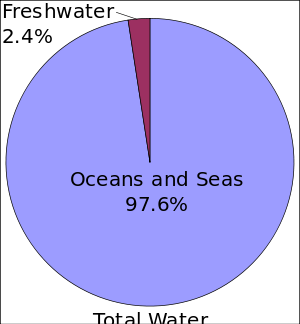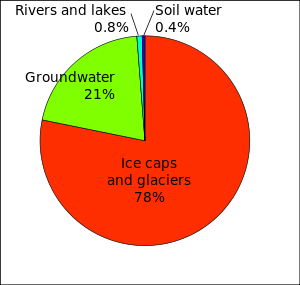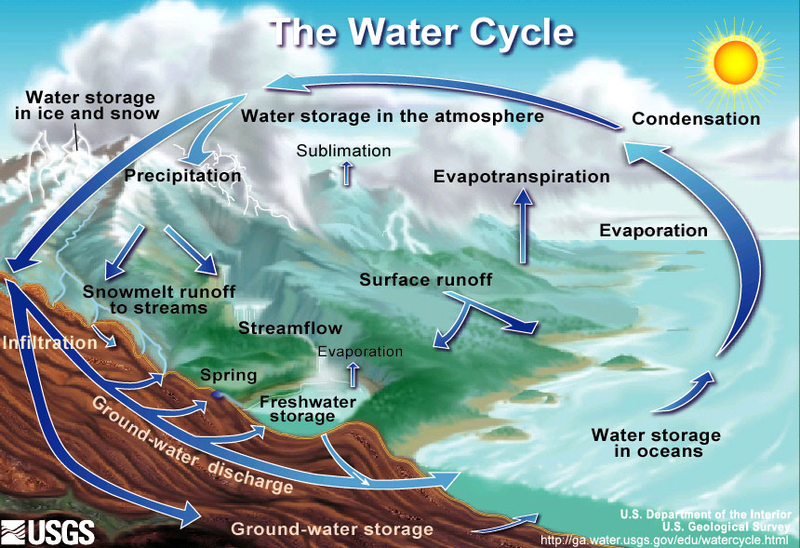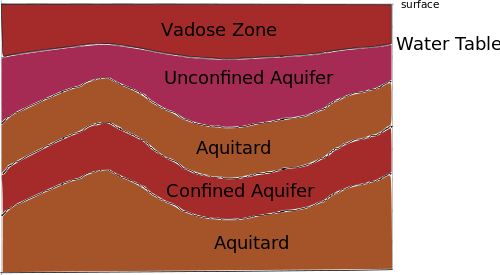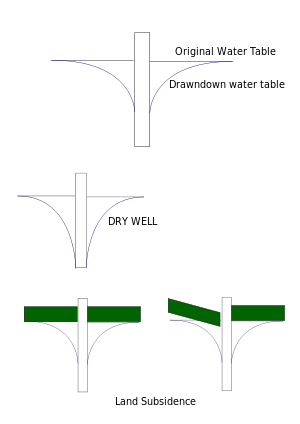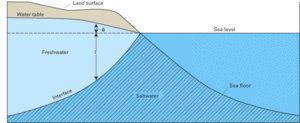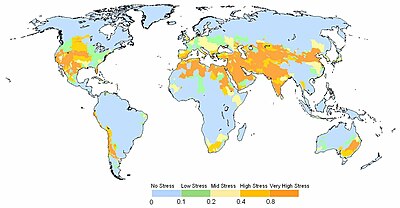Water Quantity
| Environmental Science | |
|---|---|
| Topics | What is the Environment | Planetary Boundaries | Ecological Footprint and Sustainable Development | Food and Agriculture | Population | Ecology - Definitions and Outline | Energy Flow in Ecosystems | Population and Community Ecology | Material Cycles | Biodiversity | Energy | Atmosphere and Climate | Global Warming | Air Quality | Water Quantity | Water Quality | Solid Waste |
Contents
Properties
Water has some very unique properties
- Water expands as it freezes
- Water is a liquid over a wide temperature range
- High specific heat
- Universal solvent
- High surface tension
All of these properties are due the fact that water undergoes Hydrogen Bonding. Water, expanding as it freezes, can cause water pipes to break in cold weather if precautions are not taken. This effect has an interesting consequence for ecology (in cold climates). If water was a normal substance lakes would freeze from the bottom up, causing organisms like fish to die. But lakes actually freeze from the top down.
High specific heat is why water is used for fighting fires. Water can absorb a lot of heat before it becomes steam. High surface tension causes the effect shown in the picture.
Water Distribution
The distribution of water present on the Earth is extremely nonuniform. As seen in the diagram, about 98% of the water is actually in the ocean[1]. But in the context of this section we are really interested in freshwater resources.
Considering only freshwater, by far the largest amount of freshwater is locked in ice in Antarctica, Greenland, and glaciers (see the snow and ice section on the Global Warming page). Another 20 percent is groundwater (see below). Surprisingly, lakes and rivers account for less than one percent of freshwater. Note that soil water is only 0.4%, but is very important for plants.
Water Cycle
The water cycle shows how water travels through the physical environment.[2] Knowing the water cycle is important to understanding many water supply issues. The diagram below shows the full water cycle. Also below are the definitions for the various parts of the water cycle.
|
Groundwater
Aquifers
Groundwater is not a river or lake underground. Even though they exist they are relatively rare. When geologists and environmental scientists refer to groundwater they are talking about water which is stored inside rock. All rocks contain small holes called pores. In some types of rock these pores can hold water. The schematic below shows a typical groundwater arrangement.
When above we say "significant" we mean pumpable (see next section). |
Groundwater pumping
Pumping water from a well creates drawdown (see top of the figure below). Most of the problems with groundwater quantity are due to this drawdown.
Pumping too much water, or pumping it too fast, increases the drawdown.
Hazards to unconfined aquifers from too much pumping include:
- Wells going dry - Pumping causes drawdown to reach bottom of well
- Subsidence - Removing water from aquifer weakens the rock, which then collapses
- Salt water intrusion - see figure below
Pumping too much water from confined aquifers can lead to:
- Subsidence
- Aquifer depletion - removing water faster than the recharge rate. Note some aquifers have very long recharge times.
Case Study: Ogallala Aquifer
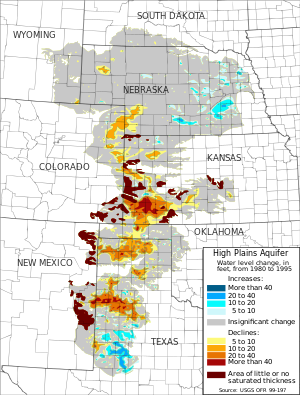
The Ogallala Aquifer is an aquifer located in the Great Plains of the United States (see map). It is one of the largest aquifers in the world. Most of the area is under intense agriculture, especially as center-pivot irrigation systems. This irrigation removes more water from the aquifer than the aquifer receives from recharge. This has caused the top level of the aquifer to fall as much as 90 m in some areas.
Water scarcity
- Water Scarcity
- Not having enough water for human use (including agriculture, industry, and residential/commercial)
Types of water scarcity:
- Drought - lack of rainfall (<70% of normal)
- Dry climate - evaporation > precipation
- Water Stress - too many people using the same resource
- Water wastage - system leaks, inefficiency, other losses
- Desiccation - drying of soil
Note that each of these require different solutions (see below).
A very useful way of categorizing the above water scarcity is as follows:
Types:
- Blue water - Water in lakes, rivers, and aquifers
- Blue water is used directly
- Green water - Water in the soil
- Green water is important for crop production
- Real scarcity - due to lack of rainfall or too many people sharing the same resource
- Apparent scarcity - sufficient water but the water gets wasted due to inefficiency and losses
We then have four groups of scarcity: real blue water, apparent blue water, real green water, and apparent green water.
Solutions - different types require different solutions.
For example: Apparent blue water scarcity can be reduced by reducing system leaks and reducing wasteful water usage.
Apparent green water scarcity can be reduced by soil conservation measures.
Case Study: Aral Sea
As shown in the map the Aral sits on the border between Kazakhstan and Uzbekistan.
The Aral Sea is actually a lake, but is called a "sea" as it is a salty lake. This salt is due to the lake being an Endorheic lake, that is it has no outlet -- which means that salts from the incoming waters do not get flushed out. It was once the third largest lake in the world.
Back in the 1960's the Soviet Union, needing hard currency, decided to use the area near the Aral Sea to grow cotton. To grow this cotton (which requires a lot of water) in this semi-arid region they took water for irrigation out of the Amu Darya and the Syr Darya (the two main rivers which flow into the Aral Sea), reducing the water flow into the lake.
This water removal led to a dramatic decrease in the extent of the Aral Sea. The lake now has only about 10% of the original amount of water[3]. In fact the "Aral Sea" is no longer a single lake, but has split into two lakes (the North Aral Sea and the South Aral Sea).
Some people call this one of the worst environmental disasters ever.
Flooding
The opposite problem to water scarcity is having too much water, thereby creating floods.
Floods are natural phenomena and beneficial. They leave silt for farmland and recharge groundwater. Ancient Egyptian civilization would not have existed if it was not for annual floods of the Nile River. Egypt is in the desert, but flourished due to silt from the upper parts of the Nile River in the mountains of Ethiopia. This silt was deposited in the Nile delta and allowed the Egyptians to grow grain and other crops. It is not an accident that all major ancient civilizations, with one exception, were centered around rivers.
The problems with flooding are mainly due to human actions which either increase the amount of flooding or make the impact of the flooding greater. Those actions include:
- Drainage of wetlands. Wetlands (including rice fields, etc.) act as natural storage areas reducing the amount of coming downstream. Draining or filling of wetlands reduces this storage.
- Channelization of rivers. Channelizing means to dredge out the bottom of a river in order to allow bigger (and hence deeper) boats. However, changing the shape of the river changes the streamflow. Among other things this can cause the water to flow faster and increase the flooding.
- Building on floodplains. A floodplain is the area in which a river naturally floods on a regular basis (typically once a year). People like to build houses, businesses, etc. on floodplains, which then causing problems.
- Urbanization. Concrete and asphalt prevents infiltration of water, which then causes increased runoff.
- Deforestation and removal of vegetation. This effect is similar to urbanization. On a slope full of trees or other vegetation, water must take a longer path increasing the time water has to infiltrate, thereby reducing runoff.
Other issues
Public vs. private water supply
There is a debate whether water supply should be owned by private companies or public governments
One side claims that private companies are more efficient.
The other side says that water supply is a basic service which should not be driven by profit
Transboundary water issues - whose water?
Problems occur when upstream countries withdraw too much water or release large amounts of water. Problems can be seen, for example, in the Nile, Ganges, and Mekong Rivers.
Notes
- ↑ A common misconception is that 75% of water is in the oceans. In fact that is the percent of water surface area compared to land.
- ↑ For other cycles (carbon, nitrogen, and phosphorus) see the Material Cycles page.
- ↑ https://earthobservatory.nasa.gov/images/77193/the-aral-sea-before-the-streams-ran-dry
